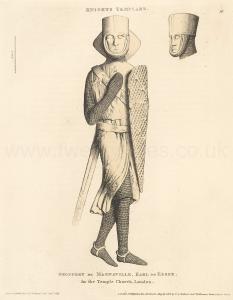Effigy of Geoffrey Mandeville
Effigy of Geoffrey Mandeville is in Monumental Effigies of Great Britain.
THIS effigy is perhaps rightly assigned to Geoffrey de Mandeville, Earl of Essex. His grandfather of the same name came over with the Norman William, and was rewarded for his services in the invasion and conquest of England, by the gift of numerous lordships, which descended to William his son, who married Margaret, daughter of Eudo Dapifer, or Steward, to William the First. Geodrey, the supposed subject of this effigy, was their son and heir, and in the 5th of King Stephen fined for the livery of his inheritance. He was hereditary Constable of the Tower of London, and was created by King Stephen, by charter, Earl of Essex. He however took part against Stephen with the Empress Matilda; and she also not only constituted him by charter Earl of Essex, but made him hereditary Sheriff of London, Middlesex, and Hertfordshire; and gave him, moreover, the lands of Eudo Dapifer in Normandy, and his office of High Steward as an hereditary right. King Stephen in 1144 seized his person, and obliged him, as the ransom for his liberty, to yield up possession of the Tower of London, and his castles of Pleshey [Map] and Walden, in Essex; the latter of which was his chief family seat. The warlike Geoffrey having, however, procured his enlargement, associated to himself certain mercenary bands, at the head of which he ravaged the royal demesnes, and plundered the Abbey of Ramsey. For this deed he incurred ecclesiastical excommunication. Laying siege to the Castle of Burwell, in Cambridgeshire, he received a mortal wound in his head from a dart, and finding his fortunes in this world set at rest, began to make what provision he could, at so short a notice, for those of the next. Some Knights Templar coming to him in his last moments, he endowed their fraternity with certain of his lands, and put on the habit of their order as a passport to heaven. Still under sentence of excommunication, they could not give him Christian burial, but they hit upon the notable expedient of wrapping his corpse in lead, and suspending it from a tree in the garden of the Old Temple, in Holborn. After some time his absolution was obtained from Pope Alexander the Third, and his body was taken down and buried in the round or most ancient part of the New Temple Church, which now serves as a porch to the main body of the building. This may account for the style of the effigy on his coffin lid, which does not appear to have been made before the latter end of the twelfth century. The costume of this effigy is exceedingly remarkable. On the head is a cylindrical, or pot like, chapelle de fer. The hauberk of chain-mail envelopes his hands, forming a sort of glove; and it may be here remarked that the most ancient gloves had not fingersa. He wears a long surcoat over his armour; a broad belt, and a very broad-belted sword dependant from the side; a long kite-shaped shield, covered with fretwork. His right arm is crossed upon his breast. The  Mandeville Arms was quarterly, Or and Gules. Dugdale says this Geoffrey added a carbuncle to his arms. One, indeed, appears on the shield of the effigy; but at this early period it seems very doubtful that it is really an heraldic distinction. On his legs are chausses, or stockings of mail, and the straps, and heel portion of the pryck-spurs attached to them, remain. The style of the figure has an expression of martial grandeur.
Mandeville Arms was quarterly, Or and Gules. Dugdale says this Geoffrey added a carbuncle to his arms. One, indeed, appears on the shield of the effigy; but at this early period it seems very doubtful that it is really an heraldic distinction. On his legs are chausses, or stockings of mail, and the straps, and heel portion of the pryck-spurs attached to them, remain. The style of the figure has an expression of martial grandeur.

Details. The chapelle de fer, mails of the hauberk covering the neck.
Note a. I have somewhere seen gloves with fingers forbidden to be worn by the members of an ecclesiastical order, as being a luxury.
